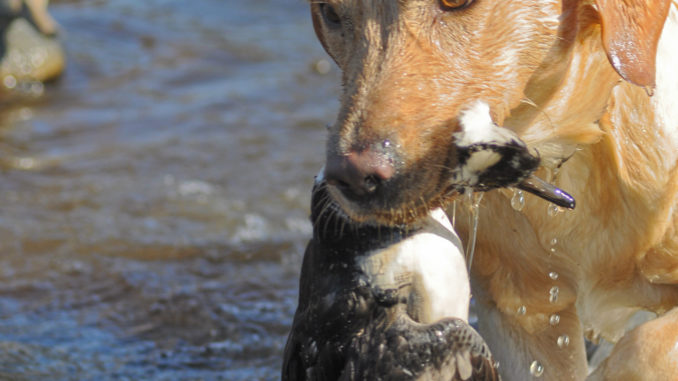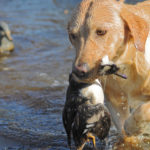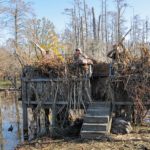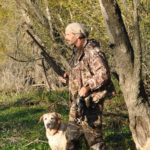
Waterfowl hunters aiming for wood ducks find rivers, streams and swamps hard to beat, especially in eastern North Carolina.
The most-colorful, handsomest duck North Carolina waterfowlers have a chance to hunt is the male wood duck.
With its iridescent green, black and white crested head, black eyes centered inside fiery red circles, an orange-yellow bill dipped in black, mottled-in-white and rust-colored nest feathers, white underbelly, black back and wing feathers outlined in streaks of white, the male woodie has little competition from other species when it comes to making a fashion statement.
Fortunately, North Carolina hunters have no problems finding wood ducks; they live in every county from Dare to Cherokee. In fact, woodies may outnumber any other species, a good reason they are often called the “Carolina” duck.
Like Canada geese, North Carolina has two populations of wood ducks — those that live here year-round and those that migrate in from the north each fall.
Although they’ve ranked second to for years in Atlantic Flyway harvest numbers to mallards, more wood ducks may live in this state because they fly almost exclusively at the crack of dawn and sunset, on the fringes of legal shooting hours, and they’re extremely difficult to hit.
Simply put, shotgunners hit air most of the time when shooting at woodies, because they’re relatively small and extremely fast fliers — think about trying to hit a dove coming through a living room with only a night light glowing. Comparatively speaking, the difference in shooting wood ducks and mallards is like trying to down hummingbirds and sea gulls.
Clark Purvis of Hobgood, a tiny hamlet in the southeastern corner of Halifax County, has been guiding duck and goose hunters for 20 years — since he was 19.
“My dad once owned several gun clubs, and I’ve been guiding since I got my captain’s license when I was 19,” Purvis said. “I’ve hunted all over eastern North Carolina.
“I take people hunting at Core Sound, Currituck, the Roanoke River and the Neuse River near Grifton,” said Purvis (252-826-4288), who owns Roanoke River Waterfowl Guide Service.
Purvis said he’s learned over the past 20 years, while hunting from Currituck Sound to the Neuse River swamps, to follow the migration patterns of waterfowl.
“Wood duck availability depends on three main things — water, acorns and (hunting) pressure,” he said.
Purvis said eastern North Carolina is home to a few “summer ducks” that remain in the area year-round, but in the fall, flights of ducks pitch into the state’s creeks, rivers and swamps — if cold-enough weather pushes them south. But in a mild winter, ducks don’t migrate in great numbers.
“Wood ducks, in a good year, will be from the Chowan River and along the Roanoke, Tar and Neuse river swamps,” he said. “Most wood ducks in the Eastern Flyway, during a good year, will winter from the Chowan River to South Carolina. That’s where the majority of them are shot.
“But they’re not easy to hit. It took me a while to get where I killed three wood ducks (the daily limit) in one hunt. For years, the most I’d ever got was two. I finally shoot three wood ducks two years ago, but I also was hunting where it wasn’t unusual to see 1,000 wood ducks in a day.”
As for the keys to wood duck availability — decent water levels, food and pressure — Purvis said given the first two, keeping hunting pressure low is a real boon to finding wood ducks, which have good memories and can become scarce when shot at too often in one area.
“Hunting pressure is the key, I believe,” he said. “If we’re doing any kind of duck hunting, when mallards are thick, we don’t also shoot wood ducks.
“You can pressure wood ducks too much. I don’t like to shoot the same spot more than once in the same week. More than once a week is too much.”
As bow hunters recognize September and October as great times to hunt deer around oak trees because acorns are falling, Purvis said if a waterfowler wants to find wood ducks, all he needs is a swamp with water oaks — often incorrectly called “pin oaks” — nearby. Woodies, which will walk to feed or dive to get to falling water oak acorns, love them as much as whitetails savor white oak mast.
“It’s sometimes a problem in eastern North Carolina after hurricanes come through, because they can wipe out oaks,” Purvis said. “That happened with Hurricane Irene; we lost a lot of oaks, and the woodies didn’t have a good food supply.”
Purvis said hunters have to be careful, though, when they find a water oak along a river bank dropping acorns into the water because “that’s when you’re most likely to see mallards and wood ducks together.”
Purvis said good places to find wood ducks are beaver ponds lined with water oaks, but food availability, especially for woodies, is a key to any kind of duck hunting.
“I don’t care where you’re hunting in eastern North Carolina,” he said. “Never underestimate the power of acorns.
“Ducks have to have a certain amount of energy to get through the winter. It’s Mother Nature’s way of taking care of animals in the winter. That’s why mallards and wood ducks want acorns; the protein in acorns gets them through the winter.
“During mating season (September) wood ducks also need energy. They (males) fight in the air and bite each other’s wings and need energy to do that.”
Like deer, wood ducks also will chow down on agricultural crops.
“They especially like soybeans, and farmers grow a lot of beans in eastern North Carolina,” Purvis said. “But if you’re hunting public land, like the Roanoke River (National Wildlife) Refuge, there’s not much crop land, so you need to find falling acorns.”
Purvis’s favorite weapon for ducks is a 12-gauge autoloader with No. 4 composite shot.
“I’ve gone to using No. 4 Hevi-Shot,” he said. “Just look at the math. It’s is a little more expensive than steel, but you get what you pay for. If you use steel, you need to be a really, really, good wing shot.
“People also will spend tons of money on the latest guns, but they don’t shoot with the gun to see if it’s throwing a proper pattern. A duck hunter needs to pattern a gun, then choose a proper choke.”
Purvis favors a modified choke.
Duck hunters are accustomed to big rafts of decoys, but that’s not the case when hunting wood ducks in swamps.
“Duck hunters are fanatics and like to buy a lot of gear, but you don’t need it for hunting swamps,” Purvis said. “I don’t use a lot of decoys.”
Purvis puts out maybe a dozen decoys during a hunt, but these artificial ducks have a special characteristic — “I want to see more movement among the decoys than in the blinds,” he said.
After placing decoys within 40 yards of the blind, Purvis uses a jerk cord that extends to the faux ducks. He’ll twitch the cord to make the decoys move and attract the attention of flying ducks.
Purvis’s assistant guide, Josh Green, likes a mixture of decoys.
“I like a little white in a spread of decoys, so I put a pintail or two in them,” he said. “I think the white helps. I also believe in using a Mojo decoy.”
Movements by hunters, either standing against a tree or in a blind, should be kept to a minimum, so Purvis recommends wearing camouflage face paint or some type of camo face covering.
“Ducks have amazing eyesight, and you can make a wood duck or mallard flare off just by looking up too soon; they spot your face,” he said. “Ducks also can see a flash of a shotgun and know what it means.”
“Wood ducks fly river bottoms and creeks,” Purvis said. “They’re not like mallards that get up high.”
Wood ducks roost at night in trees around swamps and marshes, and the worst thing a hunter can do after locating a roost is the shoot ducks coming to or leaving, Purvis said. Wood ducks will leave a roost where they’ve been peppered by shotguns, and they won’t fly to known feeding areas where Purvis takes hunters.
Studies have shown wood ducks fly, on average, 30 minutes before sunrise and 20 minutes after sunset.
“I tell kids not to shoot at roosts,” he said. “You can mess up a good place to hunt by shooting up wood duck roosts.”
The only time hunters might hunt wood ducks around a roost is the last day of the season.







Be the first to comment